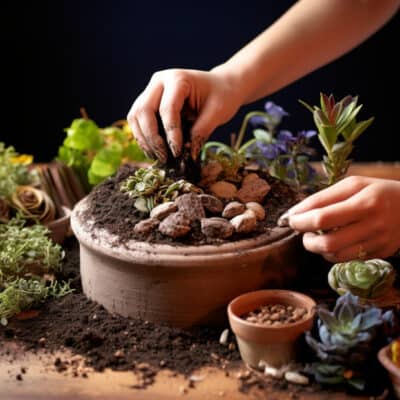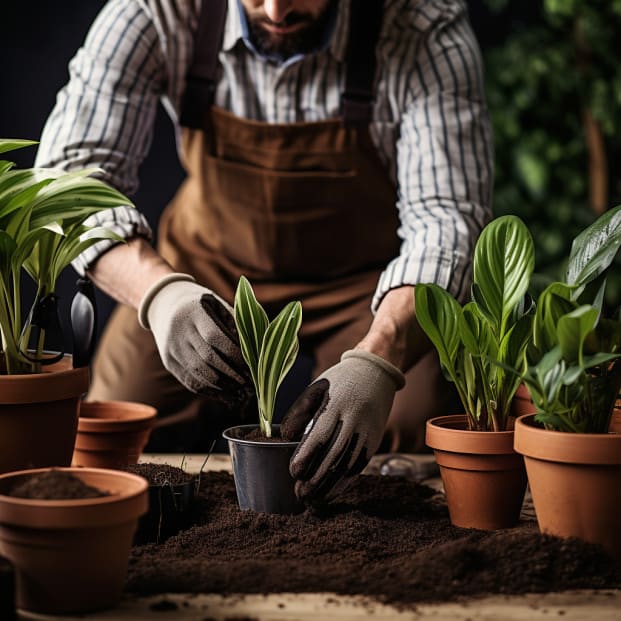To properly care for your snake plants and ensure their healthy growth, preparing the soil correctly is of utmost importance.
Choosing the perfect soil mix is more complex than you may think—snake plants come in many varieties, each with different soil needs.
Providing the right growing conditions ensures your snake plant thrives for years, while an improper mix can lead to root rot.
Keep reading to find out the perfect soil mix for your plants!
KEY TAKEAWAY
How should I prepare soil for snake plants?
Be sure to use a well-draining soil mixture with at least 50% materials like perlite (1) or pumice to keep the soil loose and airy.
Choose the right potting mix based on your snake plant variety’s individual needs for moisture levels.
What Kind Of Soil Should I Use For A Snake Plant?
When it comes to choosing a soil for your snake plant, most folks will tell you to go with pre-packaged brands.
But I decided there was a better way.
Before getting any potting mix, it’s important to understand a snake plant’s basic needs.
These plants come from dry places with well-draining dirt.
Their roots need space to breathe.
And like us, snake plants require certain nutrients to live healthy lives.
Drainage is key since snake plants are used to arid conditions.
You don’t want soggy soil sitting around their roots.
I make sure to use ingredients like perlite or pumice that keep water moving.
These aeration bits are essential to avoid rot.
Aeration is another must.
Compacted soil can suffocate delicate roots.
I use plenty of those same drainage boosters to leave pockets of air throughout.
No compacted clumps allowed when I make my mixes.
Nutrients should not be overlooked either.
Different minerals and vitamins empower growth.
My mixes incorporate organic compost as a natural source.
This compost provides trace nutrients without being too “hot” and likely to burn sensitive roots.
By understanding a snake plant’s nature and requirements, I craft custom blends for each variety in my care.
Drainage, aeration, and nutrients – my mixes have them all in perfect balance.
While store brands can work, learning soil basics is key to true success.
I invite you to do the same and discover the joys of making mixes tailored to your plants’ specific needs.
So in summary, think drainage, aeration and nutrients.
Consider where snake plants originally came from and what they need.
With some know-how, you can develop mixes that exceed any bagged brands.
Best Soil Mix For Snake Plant
Snake plants can survive in less-than-ideal conditions. But to help them truly thrive, you’ll want to use the right soil mix.
Here are some tips based on my experience keeping snake plants happy for years:
Drainage is key. Snake plants are prone to root rot if their soil stays soggy. I like to use a mix that has great drainage.
Cactus/succulent soil works well because it dries out quickly after watering. You can also add perlite or small gravel to regular potting mix to improve drainage.
Nutrient-rich soil nourishes growth. While snake plants are resilient, a rich soil encourages healthy green leaves and occasional blooming.
I add compost to mine for natural nutrients.
Organic potting soils labeled for houseplants or vegetables provide balanced nutrition too.
Test different ratios to find your snake plant’s preference. Some like soil that’s half compost, while others do best with a quarter ratio.
Play around and see how it responds with new growth. In my experience, most snake plants are fine with a 1:1:1 mix of compost, potting soil and perlite.
Repot only when roots fill the container. Snake plants have a hardy rootball. I wait until it’s bursting through the drainage holes before upsizing. This prevents overpotting which can lead to root rot issues.
Avoid soils meant for acid-loving plants. Cactus soil’s alkaline pH suits snake plants better than soils for orchids or blueberries that need more acidity. Stick with soil labeled for neutral-pH plants like succulents and houseplants.
With the right well-draining, nutrient-rich soil and occasional repotting, your snake plant will stay healthy for years. Let me know if you have any other questions!
How Do I Make My Snake Plant Soil?
After trying different soil mixes (2), I’ve found two blends that work wonders for my snake plants. While you can try other combos too, here are the ones bringing me great results:
The first is nice and simple, using three ingredients. I mix 3/4 part potting soil with 1/4 part succulent mix.
Then I stir in a handful of organic compost. This snake plant potting mix drains well thanks to the succulent soil.
The compost provides nutrients without extra moisture issues. A backup soil mixture I’ve had luck with substitutes peat moss for succulent dirt.
The ratios are 1 part garden soil, 1 part peat moss, and 1 part perlite or coarse sand.
Like the other, it nourishes plants while keeping snake plant soil from becoming soggy.
Drainage is critical since snake plants thrive with dry soil for snake plant repotting. Their native habitat features porous, arid ground.
I find adding substances like perlite or pumice lets water move freely without standing. Air pockets between particles also allow oxygen to reach the roots.
Of course, perfect soil requirements alone won’t support growth – warmth, light and watering are also key.
But by giving snake plants a suitable growing medium, you set them up for great success indoors.
With a little experimenting, I’m sure you’ll discover mixes as effective as the ones I use for my collection of green beauties.
Can I Use Cactus Soil For Snake Plants?

While cactus dirt can work, most lack nutrients crucial for snake plants. Talk to your garden center and see what they recommend. Often, cactus soil doesn’t include essentials like peat moss or compost.
But a simple blend of ingredients remedies this. I mix 2 parts cactus soil with 1 part peat moss and a handful of organic compost. This snake plant soil mix recipe enriches the earth.
Peat moss retains moisture, which snake plants need. And compost injects minerals without drying out. Proper hydration prevents browning leaves, especially in winter. You can also purchase blended mixes designed for multiple uses.
I’ve found success with Hoffman Organic Cactus and Succulent Soil. It contains small amounts of peat and compost and drains nicely.
Whatever soil type you choose, aeration is key. These plants evolved with porous, airy ground. I add perlite or pumice rocks to leave pockets between soil particles. This improves airflow to roots.
So in summary – enrich plain cactus soil by mixing in peat moss and compost. Consult retailers for succulent blends that meet the best soil for a snake plant’s needs too. With the right ingredients and drainage, they’ll thrive!
Can Snake Plant Grow In Sand?
Many folks think sand alone will work for snake plants. But the truth is, their needs run deeper than drainage. Sand plays an important role in succulent blends, allowing moisture to flow freely.
However, snake plant roots require more than porous quarters – they need vital nutrients and water too.
Plain sand provides neither of these key ingredients. When crafting the perfect homemade snake plant soil recipe, it’s important to consider all aspects of their natural environment.
In addition to well-draining sand, their native soils contain enriching materials we must replicate indoors. That’s why potting mixes for snake plant consistently feature potting soil, compost, and peat moss.
Organic potting soils introduce a suite of vitamins and minerals to feedroots. Compost acts as a natural time-release of nourishment.
And peat moss seals in just the right amount of hydration. Without these components added to sand, a snake plant planted directly in the substance would struggle dramatically over time.
Good soil fosters foliage production and lush appearance we all want for our plants. So while drainage is definitely key, don’t forget the necessity of nutrients!
A balanced blend best represents what snake plants evolved with – and what continues supporting their healthy lives indoors too.
When Should I Repot My Snake Plant?
Many people think snake plants thrive in cramped quarters, but the truth is even these tough plants need adequate space.
While they accept confinement temporarily, preferring smaller pots shouldn’t mean withstanding rootbound misery forever. So what signs show its time for a larger pot?
The telltale symptoms are easy to spot for the observant gardener. Droopy leaves and soil draining quickly are dead giveaways roots have consumed each nook and cranny.
Stunted growth and weird leaf issues provide clues the plant struggles to perform basic functions. Then there are the roots.
When plant roots spiral densely around the pot bottom and emerge from drainage holes, it’s a sure signal the plant is potbound.
Under such circumstances, leaves often appear yellow or brown too since the tight quarters hamper water absorption.
Although able to tolerate confinement short term, allowing a snake plant to stay overcrowded is doing it no favors long run.
Constant root squeezing generates stress that hinders normal operations. Yet repotting need not happen if the second roots touch the edge – wait for obvious signs.
Spring or summer is usually best for transplanting most houseplants, when soil conditions outside are ideal for root systems to stretch out comfortably in their new enlarged homes.
By striking a balance between sufficient space and avoiding premature disturbance, your snake plant will show its admiration through continued healthy habits.
Best Pot Size For Snake Plant
Proper pot sizing is important for snake plant happiness. But there’s no single “perfect” container – what’s suitable depends on a plant’s current dimensions.
Generally speaking, young snake plants thrive in 4-6 inch pots initially.
From there, moving up just 1-2 inches every year or two allows steady growth without cramped quarters.
So a snake plant occupying a standard 6 inch pot might do well jumping to a 7 or 8 inch potting vessel next.
Staying in the same pot for 1-2 years at a time before up-sizing gives roots time filling available space without bound restraint.
Snake plants can go this long between re-transplants thanks to durable genetics. Too large a pot, however, poses issues.
Any container over 10 inches for the average snake plant risks soggy soil. With excessive real estate to populate, roots spread thinly and slow water drainage.
This invites unpleasant root rot. Keeping increases incremental lets your snake plant strengthen steadily without stress swings.
Combined with observing whether roots choke the pot entirely, this out-gradualization approach keeps these popular plants content and thriving for decades indoors.
With a watchful eye, pot progression leads to pride in bigger, bushier blooms.
Understanding NPK Ratios for Snake Plant Soil
Snake plants need the right amounts of nitrogen, phosphorus, and potassium to stay healthy.
These three nutrients make up the NPK ratios printed on fertilizer bags.
Nitrogen helps plants make new leaves and stems.
Phosphorus assists with flowering and fruiting.
Potassium strengthens cell walls and promotes overall growth.
A good NPK ratio for snake plants falls somewhere between a 2-1-1 and a 3-1-2.
Too much nitrogen can cause soft growth that’s prone to disease and insects.
Too much phosphorus isn’t needed without flowers.
Extra potassium acts as a buffer against stress.
Indoor potting mixes and succulent soil mixes often have the ideal balance already.
Checking the bag is wise to be certain.
Advantages of Using the Best Soil for Snake Plants

The soil you use for snake plants impacts their long-term health and appearance.
Lightweight potting mixes like succulent soil or cactus mixes drain well while still holding moisture.
This prevents root rot from excess water.
They let air circulate to roots too.
Coconut coir and other fibers improve aeration and retention versus regular potting soil.
Terracotta pots are another smart choice as their porous nature encourages optimal drainage and drying between waterings.
Happy plants will reward owners’ care with many years as attractive, low maintenance indoor plant companions.
Troubleshooting Soil-Related Issues
Overwatering and underwatering can both harm snake plants if their soil remains too wet or dry for long.
Adequate drainage is key to avoiding these issues.
A pot’s material, like terracotta, and the potting mix used can make drainage easier to control.
Compacted soil impedes water movement through the root ball.
Gently loosening the surface with a knife or stick provides necessary aeration.
Nutrient deficiencies may also occur depending on the mix.
Signs are stunted growth or yellow leaves.
Occasional diluted fertilizing or repotting resolves the problem.
Paying close attention helps catch and fix any problems before they escalate.
Frequently Asked Questions
Should I use cactus soil for snake plants?
Yes, cactus and succulent potting mixes work very well for snake plants. They contain sand and perlite to create the light, well-draining blend that snake plants need. You can also make your own cactus-style mix with 1 part potting soil, 1 part perlite, and 1 part bark/pumice.
How much light do snake plants need?
Snake plants can tolerate a wide range of light conditions, from indirect light to low direct light.
Most varieties do well in medium light locations that receive around 6-8 hours of indirect sunlight per day.
Too much direct sunlight or excess light can lead to light bleaching or sunburn on the leaves.
What is the ideal temperature range for snake plants?
Snake plants are very tolerant of different temperature ranges.
They do best in average household temperatures between 60-80°F.
Extremes outside this range for extended periods could potentially cause leaf drop or stunted growth.
How much moisture does a snake plant need?
Snake plants are succulent plants well-adapted to tolerate dry conditions and withstand excess moisture.
The soil should be allowed to dry out slightly between waterings.
Overwatering can cause fungal issues or root rot due to saturated soil conditions and excess moisture retained in the pot.
How can I prevent spider mites on my snake plant?
Due to their succulent nature, snake plants are not usually prone to major pest issues.
However, spider mites can sometimes be a problem.
Regularly check leaves for any signs of webbing or very small red pests.
if spotted, isolate the plant and treat with insecticidal soap or a dilute solution according to label directions.
What type of soil is best for snake plants?
A well-draining soil mix that retains enough moisture while allowing excess water to easily drain away is ideal for most snake plant varieties.
Mimicking their natural environment, an inorganic mix containing ingredients like coco coir, perlite or worm castings works well.
This aids moisture retention without becoming saturated.
Can I grow a Sansevieria trifasciata indoors in different varieties of containers?
The popular upright leafed houseplant Sansevieria trifasciata, commonly called snake plant or mother-in-law’s tongue, can thrive indoors in a variety of containers as long as it has access to preferred light conditions and the container has drainage holes.
Potting in terra cotta, plastic or glazed ceramic containers 8-12 inches in diameter and height allows for healthy root development.
What soil amendments can I add to regular potting mix for snake plants?
Small amounts of organic amendments like alfalfa meal or coco coir can be incorporated into regular store-bought potting mix to improve its moisture retention and nutrient content for snake plants.
These amendments help the mix better mimic a plant’s natural environment without making the soil too dense or wet.
About 30% amendment to 70% potting mix by volume works well.
How often should a snake plant be watered and fertilized?
Mature healthy snake plants only need water when the top few inches of soil are dry.
During the growing season, water every 2-3 weeks.
Fertilize 2-3 times between spring and fall with a balanced liquid houseplant fertilizer diluted to 1⁄4 or 1⁄2 the recommended strength on the label.
Allow the soil to dry between fertilizer applications.
Final Thoughts
In conclusion, providing proper nourishment through soil is key to keeping your snake plant happy and healthy.
While tough, these plants still appreciate optimal growing conditions. A balanced blend meeting both drainage and nutrient needs serves them best.
Years of personal experience prove a simple recipe anyone can follow with excellent effects.
Mixing two parts potting soil to one part succulent soil, plus a handful of compost works wonders.
This custom mix ensures snake plant roots get the hydration and minerals required for strong growth. Nutrient-rich water that drains easily fosters vibrant leaves and chunky stems we all admire.
No wasted bags of pre-made soils either when a personalized blend tailored precisely suits.
Best of all, happy snake plants reward our care through season after season of lovely greenery brightening any room.
Isn’t that what we strive for in this hobby – to see our plants thrive? A little understanding of basic requirements goes a long way towards that worthwhile goal.
References
- https://thegrowingleaf.com/make-the-best-snake-plant-soil-mix/
- https://www.petalrepublic.com/best-soil-for-snake-plants/
Related Articles
- https://allthingsgardener.com/best-soil-for-snake-plant/
- https://allthingsgardener.com/how-to-splitting-snake-plant/
- https://allthingsgardener.com/how-big-of-pot-for-snake-plant/


